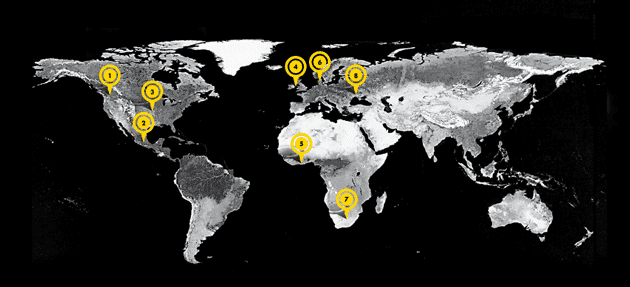Canada
In March, findings from an investigation into an incident that saw a coal ship crash into a Vancouver coal terminal causing extensive damage were released. The investigation found that poor communication and insufficient safety planning were the primary causes of the accident. In December 2012, the Japaneseowned bulk coal carrier, Cape Apricot, hit a conveyor belt at Westshore Terminals, south of Vancouver, resulting in 30 tonnes of coal being spilt into the water.
No one was injured as a result of the accident. The investigation found that poor communication on the bridge meant neither the captain nor the pilot recognised the risk in time and that none of the parties involved had formal processes to assess risks or review accidents.
[/tab][tab title=”2 Mexico”]Mexico
In February five mine workers were killed at the Charcas mine in San Luis Potosi, when a mine elevator collapsed from a height of 750 meters. The National Union of Mineworkers pointed the finger squarely at the Grupo Mexico company owned by, Germán Larrea Mota Velasco Feliciano. They say the company outsourced maintenance services to another company, “a fact that under Mexican law does not exempt them but rather makes them responsible for the contractor with respect to occupational health conditions.” In a statement the union said, “The inhumane conditions in the mines that have been concessioned to Grupo Mexico are the cause of this new tragedy that has sent 5 households into mourning, adding to previous accidents in the same Charcas mine where the company continues to cover up its violations of the laws.”
[/tab] [tab title=”3 United States”]United States
Mining fatalities increase sharply in the final quarter of 2013: According to preliminary data released by the US Department of Labor’s Mine Safety and Health Administration, 42 miners died in work-related accidents in 2013, an increase from the 36 miners who died in 2012. While fatalities occurred at a record low rate for the first three quarters of 2013, during the fourth quarter of 2013 six coal miners and nine metal/non-metal miners died in mining accidents; a significant increase from the same period in 2012, when four coal miners and two metal/nonmetal miners died.
Source: ISHN / DOL 2013
[/tab][tab title=”4 United Kingdom”]United Kingdom
The UK Prime Minister gave a significant address to the UK Federation of Small Business. He announced that “[his] Government has already stopped needless health and safety inspections and will scrap overzealous rules which dictate how to use a ladder at work or what no-smoking signs must look like.” “We’ve changed the law so that businesses are no longer automatically liable for an accident that isn’t their fault and the new Deregulation Bill will exempt one million self-employed people from health and safety law altogether” he said. The attack on legal safety protections was condemned by unions, campaigners and safety professionals.
Source: OHS Reps SafetyNetJournal February
[/tab] [/tabs] [tabs style=”boxed”] [tab title=”5 Ghana”]Ghana
In March, local media reported that 5 people were buried alive in an illegal gold mining pit at Akookoso, in the Amansie Central district of Ghana. One of the victims was a one year old child who was with her parents at the time of the accident. Local media quoted ASP Prince Odoom, Commander of the Jacobu district, as saying 7 others who were also digging for gold in the same area escaped. The bodies of all 5 victims were recovered from the pit. Despite government warnings, dozens of people die in accidents in illegal mining operations every year in Ghana.
Source: http://www.punchng.com/news/fiveburied-alive-in-ghana-gold-mining-accident/
[/tab] [tab title=”6 Denmark”]Denmark
A literature review funded by the Danish Working Environment and Research Group has found that there is strong and consistent evidence that many dusts and fumes are risk factors for Chronic Obstructive Pulmonary Disease (COPD). Common identified workplace agents include welding fumes, dust, coal, asphalt, silica and cement. There are many others in a long list. According to the authors there was a “nearly uniform pattern” of exposure-response relationships between the various exposures and COPD. N.B. There is no exposure standard for ‘dust’ generally in Australia and none for dusts of low toxicity, however, there are standards for some particular dusts.
Source: OHSReps SafetyNetJournal Feb 2014
[/tab][tab title=”7 South Africa”]South Africa
In February, 9 workers were killed in a rock fall and fire at a gold mine owned by Harmony Gold in South Africa. Eight other miners working in the area at the time managed to make it to a refuge bay where they were rescued some hours later. The tragedy was the worst accident recorded in South African mining in nearly five years. Mining Minister Susan Shabangu said the incident showed that companies had to do more to improve safety in South Africa’s mines. Despite safety improvements since the end of apartheid, more than 100 miners die on average each year. “It’s really an indictment on the safety in the mining industry, especially in Harmony,” she told Johannesburg radio station Power FM.
Source: http://www.voanews.com/content/reu-south-africa-harmony-gold-stopsoperations-after-mine-accident/1847012.html
[/tab][tab title=”8 Ukraine”]Ukraine
A methane-fuelled explosion tore through a coal mine in eastern Ukraine in February killing 7 miners and injuring 9 others. Local officials said the blast occurred at the state-run Pivnichna mine approximately 15km from the city of Donetsk. The Ministry of Emergency Situations said the bodies of the victims were recovered early on February 18 and work at the mine was suspended. Poor infrastructure along with bad safety culture means that fatal accidents are a regular feature at Ukraine’s mines. More than 100 miners were killed in an explosion at the Zasyadko mine in the Donetsk region in 2007.
Source: http://www.rferl.org/content/ukraineminers-dead-explosion/25267732.html
[/tab][/tabs]













Add Comment